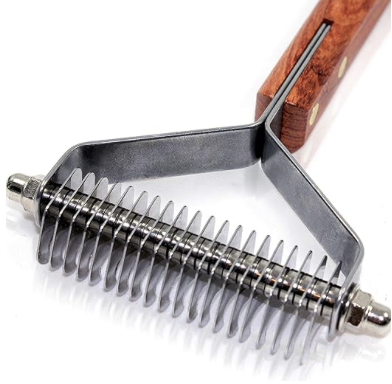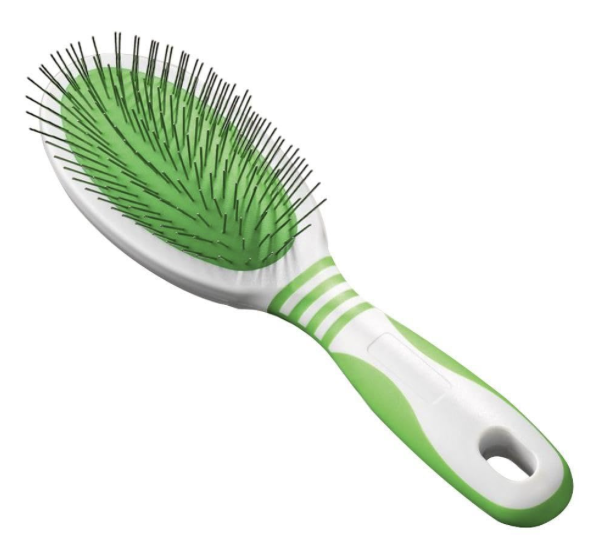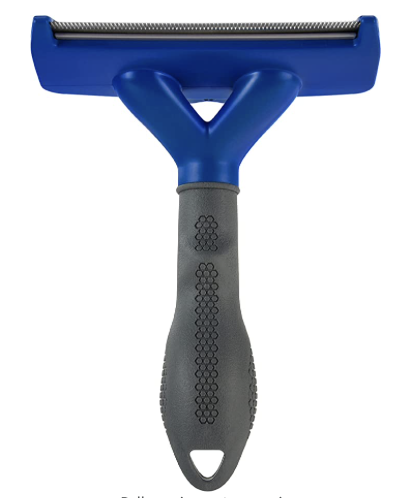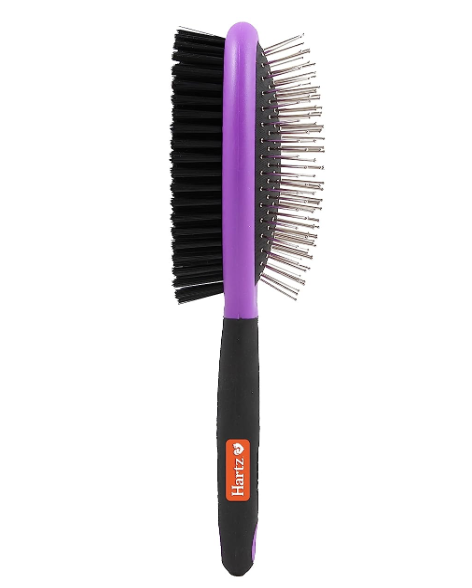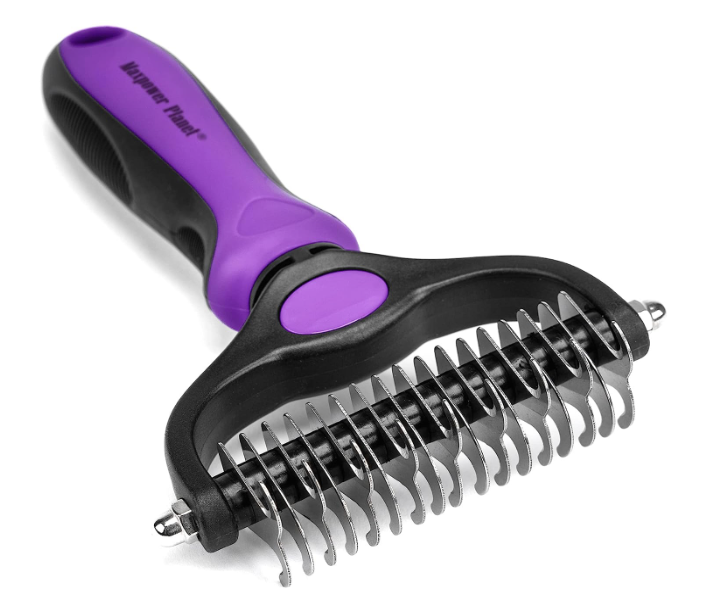7 Best Brushes for German Shepherds: What to Use and Avoid in 2024
In this guide, we’ll show you the seven best brushes for German Shepherds in 2024, helping you navigate through the maze of grooming tools to keep your canine friend looking and feeling their absolute best.
Say goodbye to shedding woes and matted fur – it’s time to discover the brushes that will make grooming your German Shepherd a breeze.
Key Takeaways
- Brushing is essential for controlling shedding, maintaining skin and coat health, bonding with your dog, preventing matting, regulating temperature, and removing dirt and debris.
- The frequency of brushing varies based on your dog’s coat and the season, ranging from weekly to more frequent during shedding seasons.
- When selecting a brush, consider factors like bristle type, undercoat rakes, ergonomic design, durability, and ease of cleaning.
- Avoid using brushes with stiff bristles, rubber brushes with nubs, fine-toothed combs, human hair brushes, electric clippers for regular brushing, or brushes with sharp or hard edges.
7 Best Brushes for German Shepherds
1. Slicker Brush:
A slicker brush has fine wire bristles that can help remove tangles and mats from the topcoat. It’s useful for regular grooming and can also help with shedding.
Our Recommendation: HERTZKO Self-Cleaning Slicker Brush
2. Undercoat Rake:
This tool is designed to reach the dense undercoat and remove loose fur. It’s particularly useful during shedding seasons to reduce excessive shedding.
Our Recommendation: PawsPamper Undercoat Rake
3. Pin Brush:
A pin brush is gentler on the topcoat and can be used for everyday brushing to keep the coat looking neat and remove surface dirt and debris.
Our Recommendation: Andis 65720 Pin Brush for Medium & Long Hair Dogs
4. Furminator:
The Furminator is a deshedding tool specifically designed to remove loose undercoat hair. It’s highly effective in reducing shedding when used regularly.
Our Recommendation: FURminator Long Hair Dog Deshedding Tool
5. Grooming Glove:
A grooming glove can be a comfortable and efficient way to remove loose hair while also providing a soothing massage for your German Shepherd.
Our Recommendation: DELOMO Upgrade Pet Grooming Gloves
6. Double-sided Brush:
These brushes typically have a pin brush on one side and a bristle brush on the other. They are versatile and can be used for both topcoat and undercoat grooming.
Our Recommendation: Hartz Groomer’s Best Combo Dog Brush
7. Mat Breaker or Dematting Tool:
If your German Shepherd develops mats or tangles, a mat breaker or dematting tool can be helpful in gently removing these without causing discomfort to your dog.
Our Recommendation: Maxpower Planet Pet Grooming Brush
Why You Need to Brush your German Shepherd
1. Shedding Control: German Shepherds are notorious shedders. Their double coat, consisting of a dense undercoat and a longer topcoat, means that hair is almost always in the air. Regular brushing can significantly reduce shedding by removing loose hair, helping keep your home cleaner and more comfortable.
2. Skin and Coat Health: It isn’t just about aesthetics; it’s also about your German Shepherd’s health. It helps distribute natural oils throughout their coat, keeping it soft and shiny. Additionally, it allows you to spot any skin issues or irregularities early, which is crucial for timely treatment.
3. Bonding Time: Brushing your German Shepherd provides an excellent opportunity for quality bonding time. Dogs enjoy physical contact and attention, and it strengthens the emotional connection between you and your furry friend.
4. Mat and Tangle Prevention: Without regular grooming, your German Shepherd’s coat can develop mats and tangles, which can be uncomfortable and even painful for your dog. Brushing helps prevent these issues and keeps your pup comfortable.
5. Temperature Regulation: German Shepherds have a coat designed to keep them comfortable in various weather conditions. Brushing helps remove excess fur during hot months, aiding in temperature regulation. In the winter, it helps maintain their insulating undercoat.
6. Dirt and Debris Removal: Dogs love to explore, and that often means they get dirty. Brushing helps remove dirt, dust, and debris from their coat, keeping them clean and odor-free.
How to Brush Your German Shepherd
Step 1: Start Early
Begin brushing your pup when they’re about 8 weeks old. Puppies might think it’s playtime, so keep them distracted with a squeaky toy while you do it. Call your GSD by their name and praise them for staying calm!
Step 2: Choose Quiet Spots
Pick 1-2 quiet grooming spots, with one preferably outdoors. Familiar and calm spots help keep your dog relaxed. If you’re indoors, choose an easy-to-clean area like a garage or bathroom. A good vacuum cleaner is a lifesaver!
Step 3: Start When They’re Calm
Brush your dog when they’re calm, like after a long walk or exercise. Use positive, soothing language to keep them relaxed. Consistent grooming times can help too.
Step 4: Begin Near the Tail
Start brushing in a small patch near their tail. It’s important to have a routine so your dog knows what to expect. Remember, grooming tools are not toys!
Step 5: Brush With the Grain
Brush their double coat with the grain using quick, steady strokes. Lift the outer coat to brush the thick undercoat, then do the top coat.
Step 6: Tackle Tangles Gently
Use a metal grooming comb and detangler spray for any tangles or mats. If needed, carefully snip out stubborn mats with grooming shears.
Step 7: Section-by-Section
Work through your dog’s coat section by section, starting from the back and moving forward. Save sensitive areas for last and take breaks if your dog gets restless. Always use calming words and soothing gestures.
Frequency of Brushing for German Shepherd
Okay, so now you know why it is a must. But how often should you do it? The answer varies based on your pup’s coat and the season:
- Weekly: At the very least, aim to brush your German Shepherd once a week. This regular schedule helps keep their coat in good condition and prevents tangles and matting. It’s like giving your pup a spa treatment right in your living room.
- Seasonal Shedding: German Shepherds are notorious for their seasonal shedding, particularly during the spring and fall. This is when they decide to part ways with a significant chunk of their fur, and it seems like you’re living in a furry snow globe. During these shedding seasons, consider increasing the frequency of brushing to a few times a week.
- Shedding Triggers: Apart from the predictable spring and fall shedding, keep an eye out for any additional triggers. Stress, hormonal changes, or environmental factors can sometimes lead to increased shedding. If you notice your pup’s fur taking flight more than usual, it’s a cue to give them some extra grooming love.
- Temperature Matters: In colder months, your German Shepherd’s double coat acts as insulation to keep them warm. Brushing can help maintain the insulating properties of their fur. Conversely, during hot summer days, regular brushing can remove excess undercoat, assisting with temperature regulation. So, adjust frequency to the weather for maximum comfort and well-being.
Other Key Features to Consider
Not all brushes are created equal. When choosing the best brush for your German Shepherd, consider these factors:
- Bristle Type: Opt for products with sturdy bristles to penetrate the dense topcoat. Look for those that have both pins and bristles for a thorough grooming experience.
- Undercoat Rake: A specialized undercoat rake can help tackle the dense undercoat, especially during heavy shedding seasons.
- Ergonomic Design: Grooming can be a workout, especially with a larger breed like the German Shepherd. Choose a brush with an ergonomic handle for your comfort and ease of use.
- Durability: Look for products made of high-quality materials that can withstand the rigors of regular grooming.
- Easy Cleaning: Cleaning the tool is part of the grooming process. Products with detachable heads or self-cleaning mechanisms can save you time and effort.
Brushes to Avoid
While many brushes can work well for German Shepherds, it’s also good to be aware of brushes to avoid. Using the wrong one can lead to discomfort, skin irritation, or ineffective grooming. Here are some types to steer clear of when grooming your German Shepherd:
- Bristle Brushes with Stiff Bristles: Brushes with stiff bristles are typically designed for short-haired breeds and can be too harsh on a German Shepherd’s double coat. They might not effectively penetrate the dense topcoat and can cause discomfort.
- Rubber Brushes with Nubs: Rubber brushes with small nubs or spikes are meant for massaging and removing loose hair from short coats. They can be uncomfortable on a German Shepherd’s long topcoat and may not reach the dense undercoat.
- Fine-toothed Combs: Fine-toothed combs are excellent for detangling and removing mats, but they may not be the best choice for everyday brushing of a German Shepherd’s thick coat. Using fine toothed combs daily can be time-consuming and may not effectively remove loose fur.
- Human Hair Brushes: Brushes designed for human hair are not suitable for a German Shepherd’s coat. They lack the structure and bristle type necessary to groom a double-coated breed effectively.
- Electric Clippers (for regular brushing): Electric clippers are mainly used for trimming and shaping a German Shepherd’s coat but are not meant for daily brushing. Using clippers for regular brushing can damage the coat and may not provide the desired results.
- Brushes with Sharp or Hard Edges: Brushes with sharp or hard edges can scratch your dog’s skin and cause discomfort. Always choose brushes with rounded tips and gentle bristles to ensure a comfortable grooming experience.
Remember that the right tool will depend on their specific coat type and grooming needs. It’s essential to choose products designed for long-haired or double-coated breeds to ensure effective and comfortable grooming.
If you have any doubts about which product to use, consult with a professional groomer or your veterinarian for guidance tailored to your dog’s unique needs.
Conclusion
In the world of German Shepherds, brushing isn’t just a grooming task; it’s a bonding experience and a way to maintain your pup’s health and happiness. By choosing the right brush and establishing a regular grooming routine, you’ll not only keep your home fur-free but also ensure your loyal companion stays comfortable and content.
Frequently Asked Questions About Best Brushes for German Shepherds
What age can you start brushing a puppy?
You can start brushing your German Shepherd puppy at around 8 to 12 weeks old. Begin with short, gentle sessions to get them accustomed to the process.
How do I keep my German Shepherd’s fur soft?
To keep your Shepherd’s fur soft, brush regularly to distribute natural oils, provide a balanced diet with proper nutrients, and ensure they stay hydrated.
How can I make my German Shepherd’s fur shiny?
A shiny coat often results from a healthy diet, regular brushing to distribute oils, and the use of a high-quality dog shampoo and conditioner.
What kind of brush should I use on my German Shepherd puppy?
For a German Shepherd puppy, a soft-bristle brush or a pin brush with widely spaced pins is a good choice. Be gentle during grooming sessions to ensure a positive experience for your pup.


